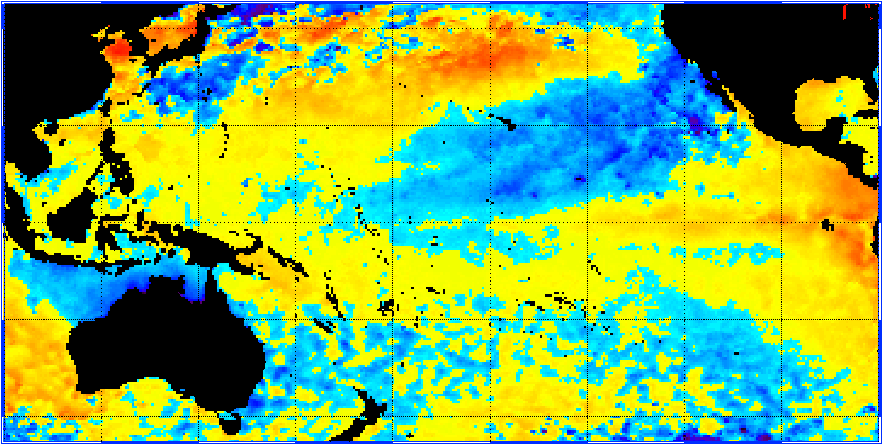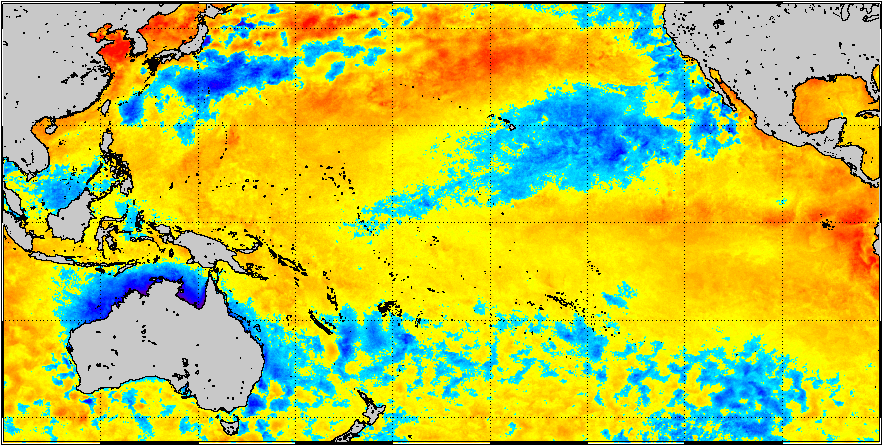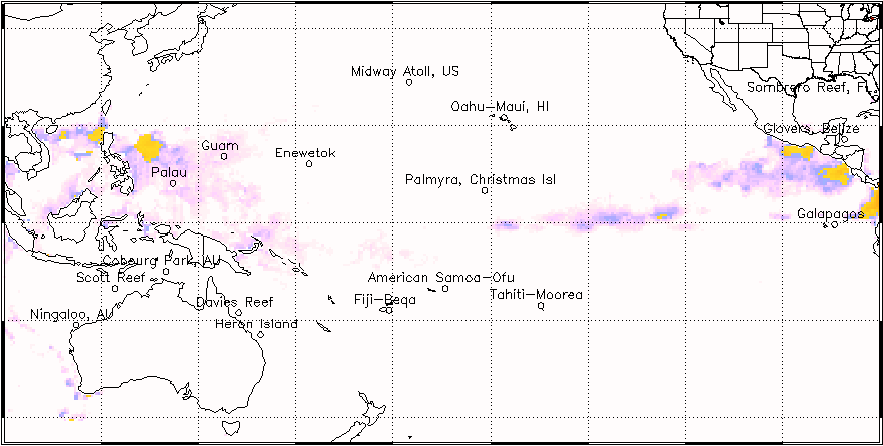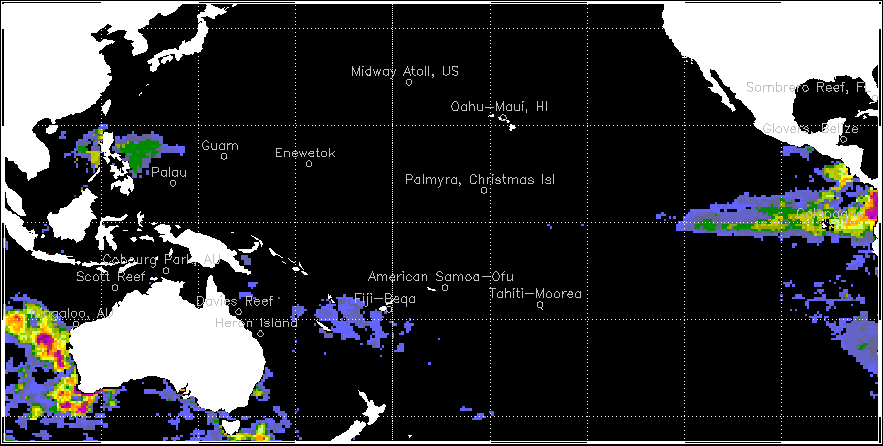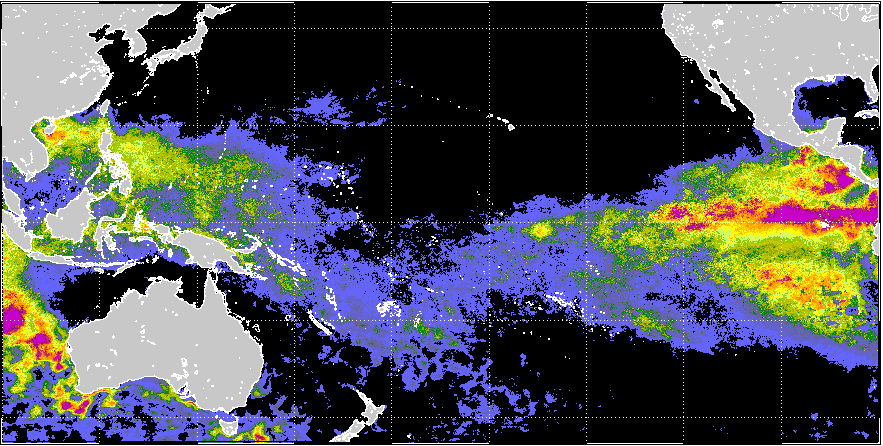(Version 1.0)
Until the product suite was retired officially on April 30, 2020, NOAA Coral Reef Watch (CRW) provided near real-time global 50km-resolution (0.5 degree exactly) satellite coral bleaching monitoring to the U.S. and international coral reef communities. For 20 years (1997-2020), these first-generation (heritage) products served as the only global early-warning system of coral reef ecosystem physical environmental changes. They monitored and predicted all major mass coral bleaching events observed globally since 1997, while also providing other critical information to users, especially during times of high heat stress. While the 50km products no longer update in near real-time, as of their retirement on April 30, 2020, since they served as vital tools for our users for so many years, we still provide an archive of the 50km data and images on our website.
During most mass coral bleaching events, sea temperature anomalies usually occur in-phase or nearly in-phase over a broad area that includes both coral reefs and their adjacent open ocean waters. This allowed CRW's 50km products to work well in detecting mass bleaching caused by large-scale thermal stresses from offshore waters adjacent to coral reef areas. However, since coastal water temperatures over reefs often exceed those seen in adjacent offshore pixels and have greater temperature gradients during bleaching seasons, CRW's 50km products occasionally underestimated the heat stress associated with a bleaching event or missed small-scale features found right over the reefs.
In addition to providing limited information regarding warming in coastal regions, especially over patchy coral reefs, CRW's heritage 50km products were based on the NOAA/NESDIS heritage twice-weekly 50km SST analyses developed in the 1970s. They therefore used only a very limited subset of SST measurements from a single satellite sensor, an old-generation cloud screening algorithm, and primitive gap-filling technique.
Advances in coral reef management practices have driven the need for higher resolution monitoring at reef or near-reef scales. Higher spatial resolution products enable monitoring of bleaching heat stress at relatively small scales specific to coral reefs and subject to localized effects (e.g., shallow water, tidal mixing, and coastal runoff). Higher resolution products allow CRW to more accurately predict mass coral bleaching events, as well as more accurately account for episodes of minor or no coral bleaching.
To address the growing demand for high-resolution coral bleaching heat stress monitoring products, research and development have been underway for multiple years with support from NASA, NOAA/NESDIS, and the NOAA Coral Reef Conservation Program. To develop the first version (Version 1.0 or v1.0) of the daily global 5km coral bleaching heat stress monitoring products, CRW used NESDIS' near-real-time daily global 5km SST analysis and reprocessed Pathfinder Version 5.2 (v5.2) AVHRR SST dataset.
CRW's v1.0 daily global 5km (0.05 degree exactly) satellite coral bleaching heat stress monitoring product suite, released in June 2012, was a new-generation version of the twice-weekly global 50km (0.5 degree exactly) monitoring product suite. It was based on the NOAA/NESDIS 5km SST analysis and provided the highest possible resolution currently feasible for global monitoring. The v1.0 5km suite included sea surface temperature (SST), SST Anomaly, Coral Bleaching HotSpot, Degree Heating Week (DHW), and Bleaching Alert Area products, matching the core 50km satellite products. The daily global 5km products provide two major improvements over the heritage twice-weekly global 50km products:
-
New-generation SST Analysis for Deriving the Product Suite: CRW's 5km coral bleaching product suite was based on the operational global daily 5km geostationary-polar-orbiting day-night blended SST analysis made available at NOAA's National Environmental Satellite, Data, and Information Service (NESDIS).
-
Improved Data Density and Spatial and Temporal Resolutions: NOAA/NESDIS' 5km SST analysis is at a much higher spatial resolution, is updated daily, and uses an order of magnitude more satellite observations from multiple operational satellites operated by NOAA, the Japan Meteorological Agency (JMA), and the European Organisation for the Exploitation of Meteorological Satellites (EUMETSAT). Compared to CRW's heritage 50km SST analysis, which was based on only a single sensor onboard a polar-orbiting satellite (NOAA-19), the inclusion of SST data from multiple geostationary satellites (e.g., NOAA's GOES-East and GOES-West, EUMETSAT's Meteosat Second Generation [MSG] satellite, and JMA's Multi-functional Transport Satellite [MTSAT]), as well as multiple polar-orbiting satellites (e.g., NOAA-19 and EUMETSAT's MetOp-A) in the 5km SST analysis increases the frequency of observations for a particular coral reef site from no more than one per day to more than 20 per day. Sub-daily observations by each geostationary satellite for an observed location drastically reduces cloud-caused data gaps in daily SST analysis.
-
Improved SST Quality with New-Generation SST Algorithm: New algorithms for deriving SST analyses from raw satellite measured radiance data are used in producing the v1.0 5km SST analysis, including a new cloud screening algorithm, SST retrieval algorithm, and gap filling algorithm. As a result, the 5km SST analysis retains many more valid SST observations (that would otherwise have been discarded in the 50km SST analysis) and provides a gap-filled SST analysis with much higher quality.
-
-
Improved Climatology: CRW's SST Anomaly, Coral Bleaching HotSpot, DHW, and Bleaching Alert Area products are very sensitive to the quality and compatibility of the climatology (long-term average conditions) used in the analysis. A new climatology at 5km resolution, matching NESDIS' 5km SST analysis, was implemented for CRW's v1.0 5km product suite. The 5km climatology was derived based on the 1985-2006 data from the Version 5.2 Pathfinder (v5.2) 4km Advanced Very High Resolution Radiometer (AVHRR) SSTs. Major steps in developing the climatology included (1) gap-filling of a high-quality subset of the original global daily Pathfinder SST data, (2) adjusting the statistical characteristics of the Pathfinder SST based on the difference between the gap-filled daily Pathfinder SST and the NESDIS 5km operational SST analysis, and (3) detrending the 1985-2006 Pathfinder SST time series to the center of the pre-determined baseline time period for the 50km product suite (1985-1993, excluding 1991-1992), to avoid the influence of long-term SST trends present in the data after 1993. The v1.0 5km climatology also addressed known errors in the heritage 50km climatology that caused overestimation of bleaching heat stress in certain areas, such as the regions around the Gulf of Panama and Gulf of Oman.
Sample figures below compare the heritage twice-weekly 50km (for the twice-weekly period of June 8-10, 2012) and v1.0 daily 5km (for June 11, 2012) SST, SST Anomaly, HotSpot, DHW, and Bleaching Alert Area products for the Pacific region. Note the finer features present in the 5km product images, which are the result of the improvements listed above.
Users are referred to the methodology for CRW's heritage twice-weekly global 50km product suite for the algorithms used to derive the SST Anomaly, Coral Bleaching HotSpot, DHW, and Bleaching Alert Area. The v1.0 5km products presented here use the same algorithms as the heritage 50km products.
Methodology of CRW's Heritage 50km Products
Archive of CRW's Heritage Twice-Weekly Global 50km Products
This v1.0 daily global 5km coral bleaching heat stress monitoring product suite, released experimentally in June 2012, significantly advanced CRW's capability for near real-time satellite monitoring of the coral reef environment. With the release of the v1.0 5km products, CRW was able to provide service at or close to reef-scales.
Development of the v1.0 daily global 5km products was accomplished through a collaboration of CRW, the University of South Florida, NASA-Ames, the UNEP World Conservation Monitoring Centre, and the Cooperative Institute for Research in Environmental Science, with funding support from the NASA Biodiversity and Ecological Forecasting program and the NOAA Coral Reef Conservation Program.
CRW recognizes that there are differences between the heritage 50km products and v1.0 5km products in certain areas, and user discretion is advised. The expectation is that the 5km high-resolution product suite will be more accurate in general, due to the improved data quality, density, and spatial and temporal resolutions.
Your feedback is important for us to improve our monitoring products. Please send your comments and suggestions to coralreefwatch@noaa.gov.



